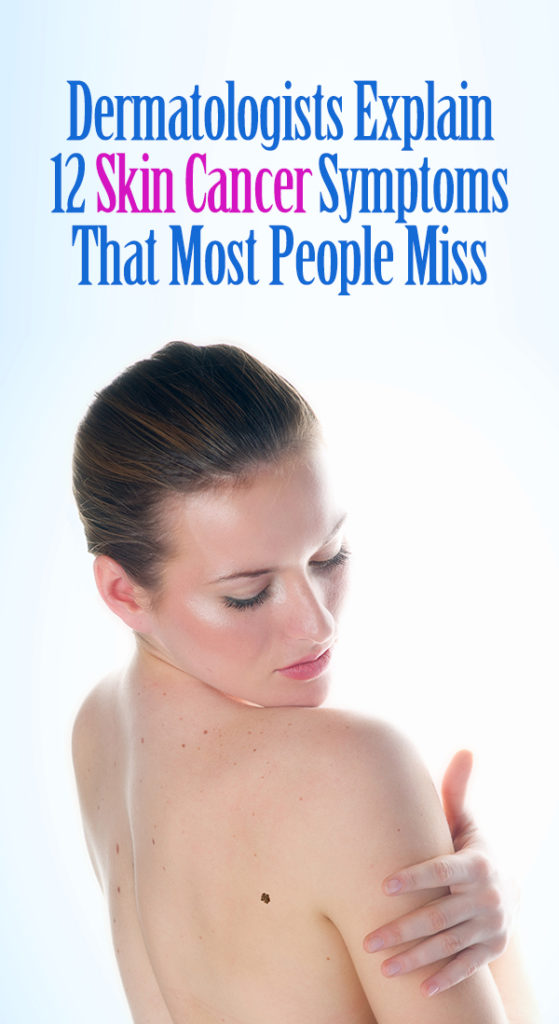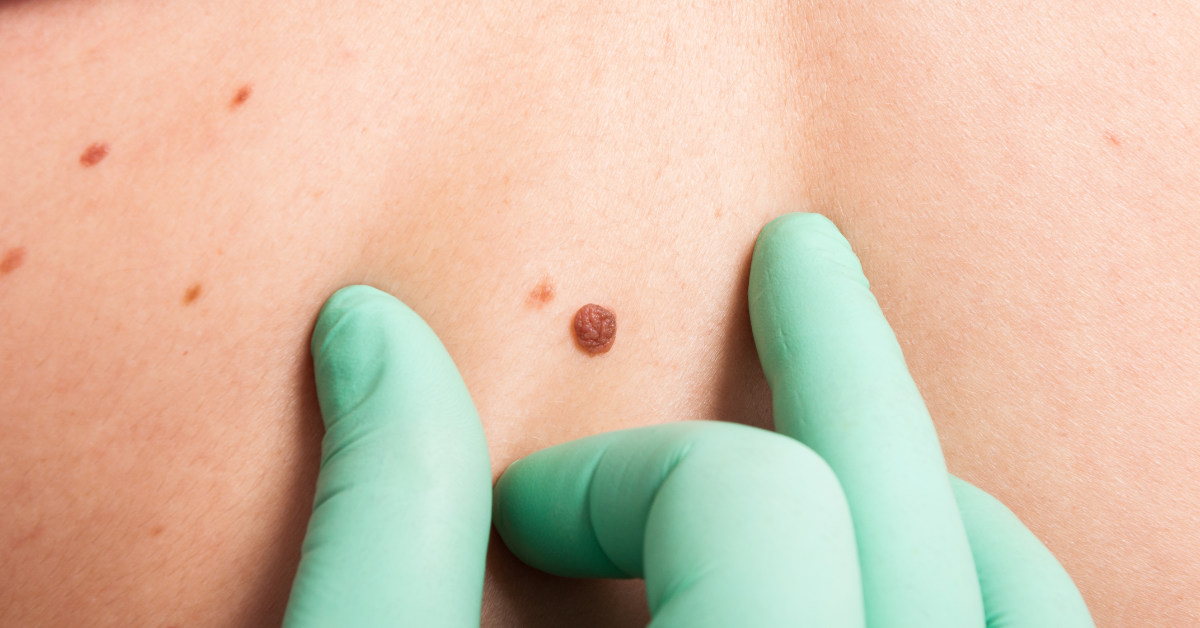Skin cancer is the most common cancer in the United States and worldwide. The Skin Cancer Foundation estimates that one in five people will develop skin cancer by age 70, and more than two people die of skin cancer in the US every hour. (1) Early detection is key to improved survival rates. According to dermatologists, these are 12 skin cancer symptoms that you may be missing.
The Silent 12 Skin Cancer Symptoms You Might Miss, According to Dermatologists
Though skin cancer is common, it is easily preventable and treatable when caught early. There are three types of skin cancer (2):
- Basal cell carcinoma (most common)
- Squamous cell carcinoma (second most common)
- Melanoma (least common but most deadly)
Unfortunately, there are many skin cancer symptoms that people don’t know about, so they don’t notice them when they appear. These are 12 skin cancer symptoms that many people miss, according to dermatologists.
1. Moles and Skin Growths That Aren’t Black or Brown
We all know to keep a close eye on our black and brown moles. However, dermatologists say that there are more types of skin growths to pay attention to than just those. Dermatologist Adele Haimovic explains that some melanoma moles can be pink or more closely match the color of your skin. Called amelanotic melanomas, they can appear more as just a bump on the skin, and therefore we ignore them. (2)
2. Family History
We don’t often associate skin cancer with family history. After all, isn’t it more related to sun exposure than anything else? While that may be true, having malignant skin cancer in your family increases your risk of developing melanoma by 50%. If you have a family history of this disease, you must have regular check-ups with a dermatologist to catch developing cancer cells early. (2)
3. Bleeding After Shaving
If you shave often, you probably cut yourself from time to time. However, if you notice this happening frequently, it could mean there is something more problematic at play. Basal and squamous cell carcinomas bleed easily from even minor traumas like being shaved over. Pay attention when you shave – if you notice the same spot bleeding every time, get it looked at by a dermatologist. (2)
4. A Recurring Pimple
Everyone gets acne, and often in the same acne-prone places. Dermatologists say pay attention to your pimples. If you’ve got one stubborn one that just won’t seem to go away, it might not be a pimple at all. (2)
“Basal cell carcinoma may look like a translucent, skin-colored, or pink pimple that does not resolve or recurs in the same spot,” says Dr. Haimovic. (2)
If your pimple doesn’t go away after two to three weeks, go see a dermatologist to make sure it is not something more serious.

5. An Odd-Mole-Out
Dermatologist Dr. Steven Wang reminds us of what dermatologists call “the ugly duckling sign”. This refers to one mole that just doesn’t look like the rest of them. Perhaps you’ve got several dark-colored moles, and then randomly one that is light brown or red in color. A darker, larger mole than the rest could also be a sign of melanoma. Basically, any mark or mole that doesn’t seem to fit in with the rest means that it is time to go see your dermatologist. (2)
Read: 6 Silent Symptoms Of Colon Cancer to Never Ignore
6. A Dark Band On Your Nail
Most often with skin cancer, we pay attention only to the skin, and rightly so. It is important, however, to pay attention to other places, such as your nails. A dark band or line down your nail could be a sign of skin cancer. (2)
“If the band has multiple different shades of brown and black, that is a concern. Also, if the width of the band is greater than three millimeters, that is another concerning feature,” says Dr. Wang. (2)
7. You Have A Weak Immune System
You have a higher risk for skin cancer if you have a weakened immune system. This includes people who’ve had chemotherapy or other immuno-suppressing treatments or medications, HIV/AIDS patients, lymphoma patients, and anyone else with a condition that compromises the immune system. (3, 4)
8. The XP Gene
The xeroderma pigmentosum (XP) gene is a rare inherited disorder that makes your skin more sensitive to UV rays. The gene hampers the skin’s ability to repair DNA damage from UV rays. Those with the condition, usually diagnosed when you are young, must take extra precautions to protect their skin from the sun. (5)
9. You’ve Had An HPV Infection
A 2012 study found that those who have had an HPV infection may also have an increased risk of developing non-melanoma skin cancers. This applied only to certain types of HPV infections. (6)
10. PUVA Treatments
Psoralen and UV-Light treatments (PUVA) are ultraviolet light treatments for skin conditions such as psoriasis and dermatitis. Studies done by the American Academy of Dermatology found that patients have (7):
- An increased risk of melanoma 15 years after their first PUVA treatment
- A five times greater risk of melanoma after 250 treatments vs people who never had a PUVA treatment
- The likelihood of developing melanoma increases after 150 PUVA treatments
If you have had PUVA treatments, it is critical that you take necessary precautions to protect your skin from the sun.
Read: ‘Keep your rear in the clear’: Woman diagnosed with colon cancer at 40 shares symptoms
11. You’ve Had Skin Cancer In The Past
Once you’ve had skin cancer of any kind, you have an increased likelihood of developing it again. In particular, squamous cell carcinoma can recur within two years and often appears on the ears, nose, and lips. Regular skin checks with a dermatologist are even more important for anyone who has had skin cancer in the past. The doctor will examine old scars from removal surgeries to make sure that the cancer is not returning. (4)
12. You Work With Industrial Chemicals
Exposure to chemicals always provides certain risks to your health. If you work in or with any of the following, you are at higher risk of developing skin cancer (2):
- In coal and aluminum production
- Steel and iron factories
- In produce-growing fields
- With industrial carcinogens (pesticides, raw paraffin, creosote, chimney soot, asphalt, shale oil, tar and pitch, and diesel-engine exhaust fumes)
Be sure to have regular check-ups with your doctor to make sure you are cancer-free, and monitor yourself for symptoms or changes.
Check Yourself
Dermatologists recommend monthly self-checks where you monitor your moles for changes and look for any other skin abnormalities. Be mindful of changes to size, shape, and color and any new marks or bumps that weren’t there before. Use the ABCDE method to help guide you (2):
A – Asymmetrical: Melanomas usually aren’t symmetrical
B – Border: Melanoma borders are often uneven
C – Color: Multiple colors or color changes
D – Diameter: Anything bigger than a pencil eraser is concerning
E – Evolving: This refers to changes in size or behavior, including bleeding, crusting, or itching.
If you are at all concerned, go see your doctor. It is better to have something looked at that turns out to be nothing than to have something bad go undiagnosed.
Keep Reading: Many people laughed when he said he had a treatment for cancer. No one said a word when he won the Nobel Prize for it…
Sources
- “Skin Cancer Facts & Statistics.” Skin Cancer.
- “12 Silent Signs of Skin Cancer You’re Probably Ignoring.” The Healthy. Lisa Marie Conklin. March 8, 2021.
- “How Are HIV and AIDS Related to Cancer?.” Cancer
- “Risk Factors for Melanoma Skin Cancer.” Cancer
- “Xeroderma pigmentosum.” Medline Plus
- “Prospective Study of Human Papillomavirus Seropositivity and Risk of Nonmelanoma Skin Cancer.” Academic. Kristin Andersson, et al. March 14, 2021.
- “The risk of melanoma in association with long-term exposure to PUVA.” Jaad. Robert S. Stern, MD. May 1, 2001.

